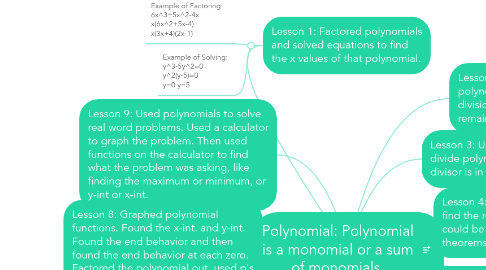Polynomial: Polynomial is a monomial or a sum of monomials.
by Shay Monteverdi

1. Lesson 1: Factored polynomials and solved equations to find the x values of that polynomial.
1.1. Example of Factoring: 6x^3+5x^2-4x x(6x^2+5x-4) x(3x+4)(2x-1)
1.2. Example of Solving: y^3-5y^2=0 y^2(y-5)=0 y=0 y=5
2. Lesson 7: Used the complex conjugate theorem and irrational conjugates theorem to identify all zeros. Complex- if f is a polynomial function with real coefficients, and a+bi is an imaginary zero of f, then a--bi a zero also because it is a CONJUGATE. Irrational- if f is a polynomial function with rational coefficients and a and b are rational numbers, and √b is a zero of f, then a--√b is a also a zero since its a conjugate also.
2.1. Example: 2(x-3)[x-(4+i)][x-(4-i)] 2(x-3)[(x-4)-i][(x-4)+i] 2(x-3)[(x-4)^2-i] 2(x-3)[x^2-8x+16+1] 2(x-3)(x^2-8x+17) 2[x^3-8x^2+17x-3x^2+24x-51] f(x)=2x^3-22x^2+82x-102
3. Lesson 8: Graphed polynomial functions. Found the x-int. and y-int. Found the end behavior and then found the end behavior at each zero. Factored the polynomial out, used p's and q's and synthetic division to find the zeros. Then found the y-int and graphed it and found the end behavior.
4. Lesson 9: Used polynomials to solve real word problems. Used a calculator to graph the problem. Then used functions on the calculator to find what the problem was asking, like finding the maximum or minimum, or y-int or x-int.
5. Lesson 4: Used synthetic division to find the reminder or if the polynomial could be factored. (Remainder/factor theorems).
5.1. Example: x^3+8x^2-5x-84 and x+5. -5 | 1 8 -5 -84 = 1 3 -20 16. So x+5 is not a factor since the remainder is 16, not 0.
6. Lesson 2: Divided polynomials by using long division to find the remainder.
6.1. Example: x+4 x^2-x-2 √x^3+3x^2+0x-7 6x+1 =x+4+ 6x+1/x^2-x-2
7. Lesson 3: Used synthetic division to divide polynomials only when the divisor is in the form x-c.
7.1. Example: b^3-4b^2+b-2 and b+1. -1| 1 -4 1 -2= 1 -5 6 -8. = b^2-5b+6 -8/b+1
8. Lesson 5: Used rational zero theorem and fundamental theorem of Algebra to help find all the solutions to a polynomial equation.
8.1. Example: x^4-2x^3-3x^2+4x+4. P-±1 ±2±4. Q-±1. Possible-±1 ±2 ±4. (Use the possible and try each using synthetic division).
9. Lesson 6: Used Descartes' rule of signs to find out the possible positive f(x)/negative f(-x) real zeros in the Polynomial, these helped when using the rational zero theorem.
9.1. Example: x^3-2x^2-21x-18. Positive: 1. Negative f(-x)= -x^3-2x^2+21x-18- 2 or 0. Then plug the positive in and the negative just like for the p's and q's.


